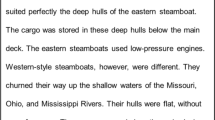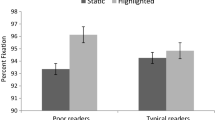Abstract
The present study examined whether there is a difference in comprehension when reading from computer-based text versus reading from paper-based text and whether there is any benefit from the ability to take notes and highlight text while reading. In two experiments, students’ reading times and comprehension scores were compared between electronic text and paper text excerpted from a popular psychology textbook. In the first experiment, students were only allowed to read, while the second experiment allowed the use of highlighting and note-taking. The results revealed no significant difference in reading times and comprehension scores across conditions. More important, there was no significant difference in highlighting and note-taking across text formats. Overall, comprehension was poor and this may reflect highlighting and note-taking as ineffective or rather the type of behavior when engaging in these types of reading aids should be reconsidered. Alternatively, poor comprehension may have been a result of low motivation from participants.


Similar content being viewed by others
Explore related subjects
Discover the latest articles, news and stories from top researchers in related subjects.References
Anderson, T. H., & Armbruster, B. B. (1984). Content area textbooks. In R. C. Anderson, J. Osborn, & R. J. Tierney (Eds.), Learning to read in American schools (pp. 193–224). Hillsdale, NJ: Erlbaum.
Baddeley, A. D. (2001). Is working memory still working? American Psychologist, 56(11), 851–864.
Baddeley, A. D., & Hitch, G. J. (1974). Working memory. In G. H. Bower (Ed.), The psychology of learning and motivation (Vol. 8, pp. 47–90). New York: Academic Press.
Baron, N, S. (2014). How e-reading threatens learning in the humanities. The Chronicle of Higher Education. Retrieved from: http://chronicle.com/article/How E-Reading-threatens/147661/?Cid=at&utm_source=at&utm_medium=en.
Berg, H., & Dawson. (2010). Not on the same page. Undergraduates’ Information retrieval in electronic and print books., 36(6), 518–525.
Byrnes, J. P. (2001). Minds, brains, and learning: Understanding the psychological and educational relevance of neuroscientific research. New York: Guilford.
Chulkov, V. & VanAlstine, J. (2013). College student choice among electronic and printed textbook options. Journal of Education for Business, 88(4), 216–222.
Daniel, D. B., & Willingham, D. T. (2012). Electronic textbooks: Why the rush? Science, 335. Retrieved October 16, 2012 from: www.sciencemag.org, 1569–1571.
Daniel, D. B., & Woody, W. D. (2013). E-textbooks at what cost? Performance and use of electronic v. print texts. Computers & Education, 62, 18–23.
Fowler, R. L., & Barker, A. S. (1974). Effectiveness of highlighting for retention of text material. Journal of Applied Psychology, 59, 358–364.
Gier, V. S., Herring, D., Hudnell, J., Montoya, J., & Kreiner, D. S. (2010). Active reading procedures for moderating the effects of poor highlighting. Reading Psychology, 31, 69–81.
Hartley, J., Bartlett, S., & Branthwaite, A. (1980). Underlining can make a difference—Sometimes. Journal of Educational Research, 73, 218–224.
Heppner, F. H., Anderson, J. G. T., Farstrup, A. E., & Weiderman, N. H. (1985). Reading performance on a standardized test is better from print than from computer display. Journal of Reading, 28(4), 321–325.
Kobrin, J. L., & Young, J. W. (2003). The cognitive equivalence of reading comprehension test items via computerized and paper-and-pencil administration. Applied Measurement in Education, 16, 115–140.
Mangen, A., Walgermo, B. R., & Bronnick, K. (2013). Reading linear texts on paper versus computer screen: Effects on reading comprehension. International Journal of Educational Research, 58, 61–68.
McNamara, D. S., & Shapiro, A. M. (2005). Multimedia and hypermedia solutions for promoting metacognitive engagement, coherence, and learning. Journal of Educational Computing Research, 33(1), 1–29.
Mueller, P., & Oppenheimer, D. (2014). The pen is mightier than the keyboard: Advantages of longhand over laptop note taking. Psychological Science, 25(6), 1159–1168.
Myers, D, C. (2011). Exploring psychology: 8th edition. Worth Publishers.
National Association of College Stores, OnCampus Research, “Update: Electronic book and eReader device report” (2011); www.nacs.org/LinkClick.aspx?fileticket=uIf2NoXApKQ%3D&tabid=2471&mid=3210.
Nist, S. L., & Hogrebe, M. C. (1987). The role of underlining and annotating in remembering textual information. Reading Research and Instruction, 27, 12–25.
Peterson, S. E. (1992). The cognitive functions of underlining as a study technique. Reading Research and Instruction, 31, 49–56.
Pickering, S, J. (2006). Working memory and education. Academic Press.
Rockinson-Szapkiw, Couruff, Carter, & Bennett (2013). Electronic versus traditional print textbooks: A comparison study on the influence of university students’ learning, 63, 259–266.
Shepperd, J. A., Grace, J. L., & Koch, E. J. (2008). Evaluating the electronic textbook: Is it time to dispense with the paper text? Teaching of Psychology, 35, 2–5.
Silvers-Gier, V., Kreiner, D. S., & Natz-Gonzalez, A. (2009). Harmful effects of preexisting inappropriate highlighting on reading comprehension and metacognitve accuracy. The Journal of General Psychology, 136, 287–300.
Sommers, S., Shin, L., Greenebaum, S., Merker, J., & Sanders, A. (2018). Quasi-experimental assessment of electronic textbook experiences: Student perceptions and test performance. Scholarship of Teaching and Learning in Psychology, 5(1), 11–22.
Terpend, R., Gattiker, T. F., & Lowe, S. E. (2014). Electronic textbooks: Antecedents of students' adoption and learning outcomes. Decision Sciences Journal of Innovative Education, 12(2), 149–173
Wieder, B. (2012). Digital Textbooks Gaining Traction in States. Retrieved May 8, 2012, from http://www.governing.com/news/state/digital-textbooks-gaining-traction-in-states.html
Woody, W., Daniel, D., & Baker, C. (2010). E-books or textbooks: Students prefer textbooks. Computers and Education, 55, 945–948.
Author information
Authors and Affiliations
Corresponding author
Additional information
Publisher’s note
Springer Nature remains neutral with regard to jurisdictional claims in published maps and institutional affiliations.
Highlights
• The purpose of the current study was to compare reading comprehension based on paper text versus electronic text when given the option to highlight or take notes.
• In two experiments, participants read a chapter from a popular introductory psychology textbook followed by a set of comprehension questions drawn from the publishers supplied database. In both experiments, half of the participants read from a traditional textbook and half read on a desktop computer. In Experiment 1, participants were only allowed to read and in Experiment 2, they could highlight the text and take notes.
• The findings demonstrated no difference in terms of comprehension regardless of the format of the text or if given the option to highlight and take notes.
• The results of the current study are informative when recommending the type of text format. They should not be taken as a recommendation to not take notes or highlight, but rather the method of taking notes and highlighting should be considered while reading.
Rights and permissions
About this article
Cite this article
Leonard, S., Stroud, M.J. & Shaw, R.J. Highlighting and taking notes are equally ineffective when Reading paper or eText. Educ Inf Technol 26, 3811–3823 (2021). https://doi.org/10.1007/s10639-021-10448-9
Received:
Accepted:
Published:
Issue Date:
DOI: https://doi.org/10.1007/s10639-021-10448-9




